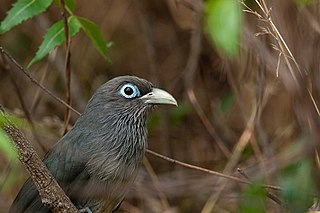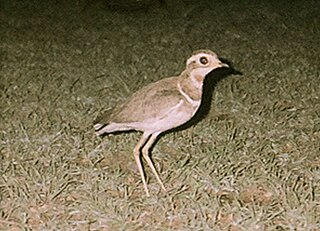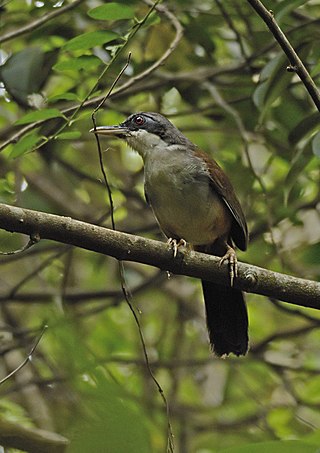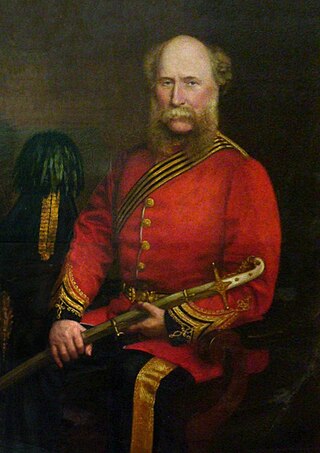
The blue-faced malkoha or small green-billed malkoha, is a non-parasitic cuckoo found in the scrub and deciduous forests of peninsular India and Sri Lanka. It has a waxy, dark, blue-grey plumage on its upperparts and has a long tail with graduated white-tipped feathers. The throat and chin are dark with spiny pale feathers that are branched. The lower belly is a dull creamy to rufous colour. The bill is apple green, and a naked patch of blue skin surrounds the eye. The sexes are alike. The blue-faced malkoha is a bird of open forests and scrub jungle.

Thomas Caverhill Jerdon was a British physician, zoologist and botanist. He was a pioneering ornithologist who described numerous species of birds in India. Several species of plants and birds including Jerdon's baza, Jerdon's leafbird, Jerdon's bushlark, Jerdon's nightjar, Jerdon's courser, Jerdon's babbler and Jerdon's bush chat are named after him.

The spot-billed pelican or gray pelican is a member of the pelican family. It breeds in southern Asia from southern Iran across India east to Indonesia. It is a bird of large inland and coastal waters, especially large lakes. At a distance they are difficult to differentiate from other pelicans in the region although it is smaller but at close range the spots on the upper mandible, the lack of bright colours and the greyer plumage are distinctive. In some areas these birds nest in large colonies close to human habitations.

The crested treeswift is a species of tree swift. It was for some time considered the same species as its eastern relative, the gray-rumped treeswift, but they do not interbreed where their ranges overlap. It is distinct in flight, with long, bowed wings and a deeply forked tail that usually appears narrow and pointed.

The black eagle is a bird of prey. Like all eagles, it is in the family Accipitridae, and is the only member of the genus Ictinaetus. They soar over forests in the hilly regions of tropical and subtropical South and Southeast Asia, as well as southeastern China. They hunt mammals and birds, particularly at their nests. They are easily identified by their widely splayed and long primary "fingers", the characteristic silhouette, slow flight and yellow ceres and legs that contrast with their dark feathers.

Loten's sunbird, also known as the long-billed sunbird or maroon-breasted sunbird, is a sunbird endemic to peninsular India and Sri Lanka. Named after Joan Gideon Loten, who was the Dutch governor of colonial Ceylon, it is very similar to the purple sunbird that is found in the same areas and also tends to hover at flowers for nectar, but can be distinguished by the longer bill, the maroon band on the breast and brownish wings. Like other sunbirds, it is also insectivorous and builds characteristic hanging nests.

Jerdon's courser is a nocturnal bird belonging to the pratincole and courser family Glareolidae endemic to India. The bird was discovered by the surgeon-naturalist Thomas C. Jerdon in 1848 but not seen again until its rediscovery in 1986. This courser is a restricted-range endemic found locally in India in the Eastern Ghats of Andhra Pradesh. It is currently known only from the Sri Lankamalleswara Wildlife Sanctuary, where it inhabits sparse scrub forest with patches of bare ground.

Sir Walter Elliot, KCSI was a British civil servant in colonial India. He was also an eminent orientalist, linguist, archaeologist, naturalist and ethnologist who worked mainly in the Presidency of Madras. Born in Edinburgh, he studied at the East India Company College at Haileybury and joined the East India Company's civil service at Madras in 1820 and worked on until 1860. He was invested Knight Commander of the Order of the Star of India (KCSI) in 1866.

Thomas Reid Davys Bell was a lepidopterist, naturalist and forest officer who worked in India. Bell collected natural history specimens, studied birds and the life histories of butterflies and moths in his spare time. His large collection of entomological specimens are held at the Natural History Museum, London. A number of species have been named from his collections, several commemorating him.

The Indian courser is a species of courser found in mainland South Asia, mainly in the plains bounded by the Ganges and Indus river system. Like other coursers, it is a ground bird that can be found in small groups as they forage for insects in dry open semi-desert country.
Charles Philip Brown was a British official of the East India Company. He worked in what is now Andhra Pradesh, and became an important scholarly figure in Telugu language literature.
Sir David Callender Campbell, was an Ulster Unionist politician in Northern Ireland.

The Wayanad laughingthrush is a species of laughingthrush in the family Leiothrichidae. It is endemic to the Western Ghats south of Goa in India. These laughingthrushes move in groups in dense forests, producing loud calls but tend to be hard to spot in the undergrowth. They have brown upperparts, a white throat, a broad black mask through the eye and a heavy bill with pale yellow on the lower mandible. Despite the name, derived from the Wayanad region, this species has a wider range than the four other south Indian species of laughingthrush that are restricted to the higher elevation hills.

The heart-spotted woodpecker is a species of bird in the woodpecker family. It has a contrasting black and white plumage, a distinctively stubby body and a large wedge-shaped head making it easy to identify while its frequent calling make it easy to detect as it forage for invertebrates under the bark of the slender outer branches of trees. They move about in pairs or small groups and are often found in mixed-species foraging flocks. They have a wide distribution across Asia with populations in the forests of southwestern and central India which are slightly separated from their ranges in the Himalayas and Southeast Asia.

The Telugu Ganga project is a joint water supply scheme implemented in 1980s by the then Andhra Pradesh chief minister N.T.Ramarao and Tamilnadu Chief minister M. G. Ramachandran to provide drinking water to Chennai city in Tamil Nadu. It is also known as the Krishna Water Supply Project, since the source of the water is the Krishna river in erstwhile Andhra Pradesh. Water is drawn from the Srisailam reservoir and diverted towards Chennai through a series of inter-linked canals, over a distance of about 406 kilometres (252 mi), before it reaches the destination at the Poondi reservoir near Chennai. The main checkpoints en route include the Somasila reservoir in Penna River valley, the Kandaleru reservoir, the 'Zero Point' near Uthukkottai where the water enters Tamil Nadu territory and finally, the Poondi reservoir, also known as Satyamurthy Sagar. From Poondi, water is distributed through a system of link-canals to other storage reservoirs located at Red Hills, Sholavaram and Chembarambakkam.

Edward Green Balfour was a Scottish surgeon, orientalist and pioneering environmentalist in India. He founded museums at Madras and Bangalore, a zoological garden in Madras and was instrumental in raising awareness on forest conservation and public health in India. He published a Cyclopaedia of India, several editions of which were published after 1857, translated works on health into Indian languages and wrote on a variety of subjects.

The statue of Thomas Munro is an equestrian statue of Thomas Munro, 1st Baronet, Major-General in the British Army and Governor of Madras from 1820 to 1827, located in the city of Chennai, India. The bronze statue sculpted by Francis Chantrey in the United Kingdom in 1834 and shipped to Madras in 1839, is one of the popular landmarks in Chennai. The absence of stirrups is one of the peculiarities of the statue and for this reason, it is also referred to as "The Stirrupless Majesty".
Samuel Stearns Day (1808–1871), also known by name Samuel S. Day, was the first Canadian-born American Baptist missionary to Telugu speaking provinces – Visakhapatnam, nearby to British Baptist missionary presence in Orissa ; and Nellore, part of then-Madras presidency, later part of Andhra, and currently part of Andhra Pradesh.

Thomas Vincent Campbell was a physician, missionary and an entomological collector in India. He helped establish sanatoria for tuberculosis treatment in Madanapalle, a hospital in Jammalamadugu which is now named after him, and the Ralph Wardlaw Thompson memorial hospital at Chikkaballapur and was awarded a Kaiser-i-Hind for his contributions to the health of the poor. His collections of Hemiptera from India resulted in the descriptions of many new species of bug, several of which were named after him.
David Callender Campbell was an Irish businessman and naturalist.
















